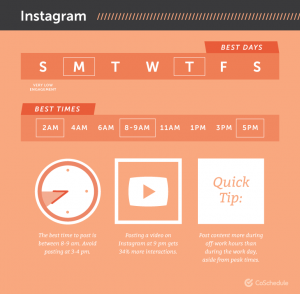Instagram continues to add followers, not in thousands, but in millions every year! Yet, you may not find your Chief Marketing Officer on Instagram, or worse, with a minuscule fan-following and posts that reflect limited brand-savvy. While marketers and advertisers look to build their marketing channels with an eye on Instagram audiences in 2018, missing out on a CMO account could count as an impediment, especially when you are targeting millennials.
Here’s a quick guide on how B2B CMOs can grow their brand value on Instagram.
The State of Instagram Marketing
The Top Trending Instagram Tech Accounts
Google: With 6.1 million followers, Google leverages Instagram by running a theme with spotlights on the letter – ‘G’, from its logo. The company shares various pictures that show ‘G’ in many usances ranging from food to slime. Colorful streets and skylines are also a part of Google’s posts.
Adobe: Adobe makes the most of Instagram to showcase its creativity via pictures of clouds or lakes. The posts would never let anyone guess that Adobe makes software but they’re impactful. 652K followers speak volumes about the impact.
IBM: The IBM Instagram account boasts of 211K followers and is all about the company’s history and its data centers. One such example is a post where it shared how the programmers at IBM contributed to the famous Apollo 13 in 1970.
HubSpot: The leading sales and inbound marketing company has a totally different Instagram strategy than others. No skylines, lakes or rainbows. All of its posts are digital marketing themed. From infographics to quotes on the best practices to memes, HubSpot shares content that marketers can relate to. 97.3K is its follower count.
Salesforce: Fairly new to the Instagram space, Salesforce has 47.1K followers. The company puts the slideshow feature of Instagram to great use by uploading multiple images which followers can swipe over. Events and outdoor spaces are the primary focus of a majority of Salesforce posts.
Instagram vs LinkedIn Marketing
There is no doubt that LinkedIn is a dedicated professional network for business and offers a great platform for B2B marketers. However, when it comes to customer reach and advertising, Instagram marketing offers a more personalized and hands-on approach in terms of customer interactions and engagement.
LinkedIn is great to connect with fellow professionals and share knowledge and information but Instagram helps in establishing a stronger brand image and resonance. The reason is fairly simple – Visual stories have a deeper impact than text updates.
Popularity, and Why CMOs Should Build Their Account
The Facebook-owned photo-sharing platform reached 800 million monthly active users (MAU) last September. This marks an incredible increase of approximately 1500% from 2012 when it had 50 million MAU. And, with the surge of inbound marketing activities, Instagram can’t be overlooked anymore, and, the reasons are simple:
- It’s an app exclusively for mobile (a majority of the audience)
- It’s visual content (more viral)
- No language barriers (effective engagement)
Simply put, Instagram can help brands cut the noise of a crowded marketplace and be heard. Contrary to some of the preconceived notions, this is not just true for B2C but holds equally true for B2B as well. In 2017, 70.7% businesses in the US were leveraging Instagram compared to 48.8% in 2016.
Instagram Marketing Myths
Resistance to change is often based on excuses or myths. Let’s bust some critical ones that have, over the years, stopped B2Bs from ‘Instagramming’.
Our target audience is not on Instagram – With 800 million MAU and counting, this is one myth that B2B marketers need to bust immediately and get on with it.
Instagram is for kids – According to Statista, 40% of Instagram users are of the 30-49 year age demographic and 64% are in the 18-29 age group. The former is the fastest growing segment on Instagram. So, it’s time to move out of the ‘for kids only’ frame of mind.
Our business content won’t sync with Instagram – Perhaps the most negative of them all. If as a B2B marketer, you feel you don’t have resonating visual content, it’s time to overhaul your entire marketing strategy.
Instagram is for CPG, FMCG, and lifestyle brands only – More than 40 million photos get posted on Instagram every day. To think that all of them are selfies, food, and B2C products is a clear error in judgment.
Once these myths have been busted, to succeed with Instagram marketing, like any other type, is all about a clearly defined strategy. And, with predictions that 1 billion MAU are not far flung, Instagram deserves the attention of B2Bs.
Here’re some elements that are pivotal to a successful B2B marketing strategy on Instagram.
Real-Time, Genuine UGC
Your leads and prospects using Instagram seek content that is authentic and provides a sneak peek into your products or offerings and your culture. Therefore, it’s time to get real. Real-time User Generated Content(UGC) like live streaming or videos ensures high brand resonance and recognition. UGC ensures a human element is added to B2B marketing and helps marketers establish a genuine connection with potential customers. Unlocking the true potential of hashtags is what makes your UGC discoverable.
According to Croudtap, “Advertisements with UGC content get 4x higher click-through rates. Plus, user-generated content is 35% more memorable than other media.”
For instance, Buffer leveraged UGCs from global customers featuring how they work, play and live. Calling itself #digitalnomads, the company has used simple, effective hashtags like #bufferstories, #buffercommunity, #bufferlove, and #bufferspaces.
For Metrics, It’s Sanity over Vanity
B2B marketers on Instagram must be wary that they don’t gauge their performances based solely on vanity metrics. Increased likes and clicks are good. However, they won’t reveal the relevance of your reach which is critical to a B2B marketer. Metrics such as comments on posts and new followers are better indicators of how much exposure your business is garnering on Instagram.
Instagram for Business was introduced in 2016, and has an inbuilt analytics tool allowing marketers to view metrics in real-time on the performance of posts and stories. It also helps in getting deeper insights into followers and their respective interactions with marketer’s content. This, in turn, helps in identifying the right leads.
For advanced analytics, platforms like Iconosquare, Hootsuite (which itself is very active on Instagram), Sprout Social, and others can offer you metrics such as churn rates of followers. In essence, your ABM funneling can actually begin here.
Consistency in Messaging
Instagram, being a very user-friendly app in terms of posting content, is also very dynamic. It’s a fun space and B2B marketing need not be boring. Keeping your posts dynamic, fun, but relevant, helps you appeal to the audience while showcasing different shades of your business.
For instance, a small video snippet on how your CRM software works can be followed by animated cat video depicting customer retention or a humorous GIF. How’s the latter relevant? It shows that your brand has a work and play culture. And, that’s a great thing for enhancing brand image.
Engagement Is The Foundation To Carve Your Niche
B2B marketers need to understand that brand content posted on Instagram is just half the job done. The idea is to get into conversations and engage. Like any other social space, your Instagram presence needs to be optimized for listening and responding. Your leads and prospects will take the time to engage with you only if you find the time to engage with them. That’s the symbiosis and that’s how B2B brands can carve a niche for themselves on Instagram.
Tell Tales that Grip Audiences
Brands that have succeeded on Instagram have one thing in common. They’ve been great visual storytellers and that is the gateway to develop a large set of followers. For this, Instagram Stories is a fabulous opportunity to build videos, slideshows, montages, collages, and much more. And, it’s far more engaging and you can string a series together based on your individual audience interactions. Now, that is personalization which any lead or prospect would vouch for. Another great example is PayPal – a P2P cash transaction firm, that has 87.1K followers on Instagram. PayPal uses #paypalit, allowing users to tell their own stories by submitting their own content.
Finally, to get the timings of your Instagram post spot-on, below is quick hack by CoSchedule.

Stay Creative Without Squandering Quality
A common misconception about B2B content is that it’s mundane. Not quite! Whether you are already on the Instagram bandwagon or just about to hop into it, the focus should be on generating authentic interest and not just grabbing momentary eyeballs. Be it infographics, video, or just plain images, determining a visual voice of your own is important to make it resonate. Even your UGC must be brand-specific and echo that same visual voice as yours.
Sometimes, B2B marketers might think that their service or product can’t be brought to life through visuals. In that case, keep it simple and tell the stories of your customers.
A Proactive Approach Helps
After all, Instagram is a social app. Your customers are not bots. Keep the human touch going by interacting with them as people and not as business entities. Being grateful is a proven way to develop strong customer relations on any social platform, and, Instagram is no exception.
It’s time for B2B marketers to get out of the ‘Instagram is for B2C’ syndrome. While it may seem daunting at the beginning, if you can strike the right visual chord that resonates with your leads, prospects, and customers, Instagram can become the most prominent cog in your B2B social and content marketing wheel.












Comments are closed.